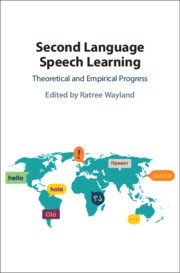Book contents
- Second Language Speech Learning
- Second Language Speech Learning
- Copyright page
- Dedication
- Contents
- Figures
- Tables
- Contributors
- Preface
- Acknowledgments
- Part I Theoretical Progress
- Part II Segmental Acquisition
- Part III Acquiring Suprasegmental Features
- Part IV Accentedness and Acoustic Features
- Chapter 13 Comparing Segmental and Prosodic Contributions to Speech Accent
- Chapter 14 Do Proficient Mandarin Speakers of English Exhibit an Interlanguage–Speech Intelligibility Benefit When Tested with Complex Sound–Meaning Mapping Tasks?
- Chapter 15 Foreign Accent in L2 Japanese
- Part V Cognitive and Psychological Variables
- Index
- References
Chapter 14 - Do Proficient Mandarin Speakers of English Exhibit an Interlanguage–Speech Intelligibility Benefit When Tested with Complex Sound–Meaning Mapping Tasks?
from Part IV - Accentedness and Acoustic Features
Published online by Cambridge University Press: 21 January 2021
- Second Language Speech Learning
- Second Language Speech Learning
- Copyright page
- Dedication
- Contents
- Figures
- Tables
- Contributors
- Preface
- Acknowledgments
- Part I Theoretical Progress
- Part II Segmental Acquisition
- Part III Acquiring Suprasegmental Features
- Part IV Accentedness and Acoustic Features
- Chapter 13 Comparing Segmental and Prosodic Contributions to Speech Accent
- Chapter 14 Do Proficient Mandarin Speakers of English Exhibit an Interlanguage–Speech Intelligibility Benefit When Tested with Complex Sound–Meaning Mapping Tasks?
- Chapter 15 Foreign Accent in L2 Japanese
- Part V Cognitive and Psychological Variables
- Index
- References
Summary
Research showed that the interlanguage-speech intelligibility benefit (ISIB) effect progressively disappeared in Chinese speakers of English as their English proficiency increased and their exposure to Chinese-accented English decreased. As a result, ISIB effects were obvious in less proficient speakers. We explore the hypothesis that ISIB is still present in proficient L2 English speakers when tasks go beyond sound transcription and relate intelligibility to more complex sound-meaning mappings. Results showed that, in general, native English speakers outperformed Chinese speakers of English showing no evidence of an overall ISIB effect despite that Chinese speakers of English rated Chinese-accented sentences as more comprehensible. Only in the compound vs noun contrasts (e.g., ‘bluebird’ vs. ‘blue bird’), Chinese speakers of English outperformed native English speakers in the Chinese-accented stimuli, showing a mild ISIB-L effect. This modest evidence in support of ISIB encourages further exploration on aspects of sound perception that could affect ISIB in proficient L2 speakers.
- Type
- Chapter
- Information
- Second Language Speech LearningTheoretical and Empirical Progress, pp. 350 - 376Publisher: Cambridge University PressPrint publication year: 2021



